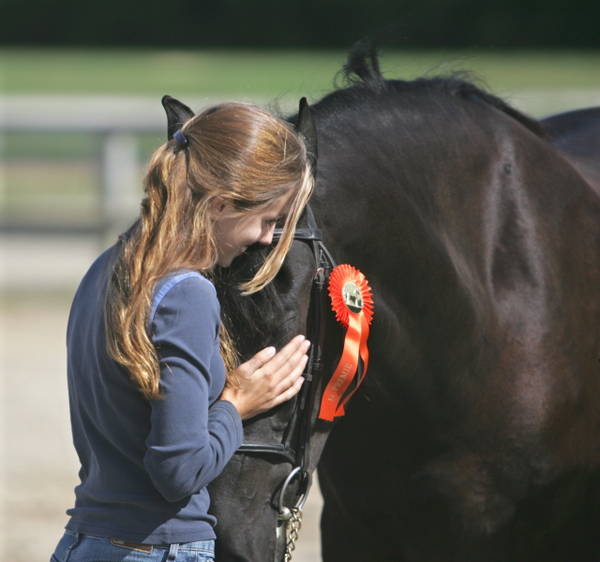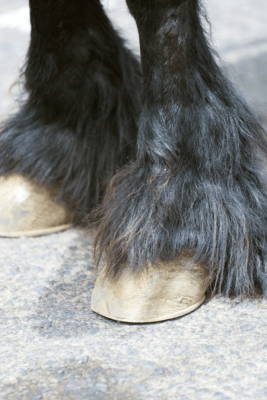When you purchase something using the retail links in our posts, we may earn a small commission.
Pastern Dermatitis or “Scratches” are a common issue seen in Friesians and other feathered breeds such as Clydesdales, Belgians, and Gyspys. You may also hear it referred to as mud fever, dew poisoning, greasy heel, or cracked heels. While some horse owners see scratches during rainy or wet weather, they can be persistent in dry weather, too.
Scratches are caused by a mix of bacteria, often fungal, and can be very difficult to treat. It often develops in excessively moist environments like damp stalls, muddy pastures, and rainy weather. If not treated appropriately they can lead to lameness, swelling, and heat in your horse’s legs.
Friesian horses have a lot of thick hair on their legs called feathers or feathering. This thick hair will trap and retain moisture creating the perfect environment for scratches to develop. Horses with white legs are also at risk because un-pigmented skin is more susceptible to sun damage, chaffing, and abrasions making them more at risk for infection.

Treating scratches can be time-consuming, frustrating, and just when you think you have it under control….it’s back again!
Most professionals will recommend carefully clipping the hair away to dry the area. Unfortunately, most Friesian owners would prefer NOT to clip any feathers off.
After years of experimenting with different treatments, here are a few of our preferred ways to treat scratches. Some of these will be dependent on where the scratches appear on your horse. We have a few horses that get scratches high up on the leg, while others get it on the fetlock.
If your horse has scratches at the fetlock, you can CAREFULLY trim the hair underneath the fetlock leaving the hair higher up intact. This takes a bit of practice, but you can end up with a cleaned-up area that still appears to have full feathers.
Next, gently wash the affected area with an antibacterial or antifungal shampoo. You can use chlorhexidine, betadine or miconazole. You don’t want to rub the area too firmly as you don’t want to break the fragile skin.
Allow the shampoo to sit for 10 minutes, then rinse. You can gently massage the scabs off, but rough scrubbing should be avoided. Pat the area dry with a towel. You can wash the areas up to once per day for 7-10 days. After this initial period, you’ll want to reduce the washes to 2-3 times per week.
There are many ointment options to apply after washing and drying the legs. Veterinarians will sometimes recommend steroids or systemic antibiotics for serious cases.
Microtek: this is my personal favorite for the treatment of scratches. It has anti-fungal properties and be sprayed on easily. We have used this for several years with pretty consistent success.
Desitin: this is a common treatment for scratches among horse owners. It will soften the scabs and provide a moisture barrier to allow healing. We’ve had mixed results with Desitin, but have horse friends that swear by it.
Bag Balm: I love Bag Balm! I am convinced it is the perfect thing for anything that ails you. That being said, it really does work on scratches. It softens scabs, provides a moisture barrier, and has antiseptic properties.
Excalibur Sheath Cleaner: Why in the world would you use sheath cleaner to treat leg bacteria or fungus? Hear me out…one of the main ingredients in this sheath cleaner is tea-tree oil. Tea Tree oil has antimicrobial properties and can help treat mild infections like scratches. You’ll want to use this in place of the antifungal shampoo during the washes, not as a topical after washing.
Vetericyn Spray: we have not had great luck with this product, but know many people who have. And, reading the ingredients, it really does have the right stuff to be a successful scratches treatment. It might be worth a try if you find the other options aren’t working for your horse.
Corona Ointment: this ointment helps to soften the scabs and provides a bit of a moisture barrier. While it has some minor antiseptic properties, this ointment simply gives the area an opportunity to heal. I will tell you this can be a super sticky mess when applying to feathered breeds like Friesians. Apply small amounts frequently.
If you are worried about your horse getting scratches, there are some ways to help reduce the chances. These are not guaranteed but certainly, help.
Keep track of your horse’s medical records with our Free Horse Record Tracker!
Prevention Tips
- Keep footing dry and use dry bedding in stalls
- Dry legs when your horse gets wet
- Avoid pastures and paddocks that are wet or muddy
- Avoid leg wraps or boots for turnout
- Trimming feathers
- Check your horse’s legs daily for signs. Early treatment is super helpful

I’ve been around horses my entire life, but my Friesian journey started just over 20 years ago. Our horses have always been a part of our family. They have traveled with us as we relocated from Vermont to New York to Iowa and finally, to Arizona. I can’t wait to share our story with you!
Related
Mar 11, 2021
What Causes Scratches in Horses, plus the Best Treatment Methods

Leave a Reply Cancel reply
@starlitridgefriesiansandfells
LET'S BE FRIENDS ON INSTAGRAM